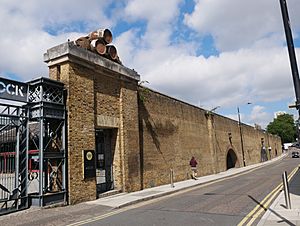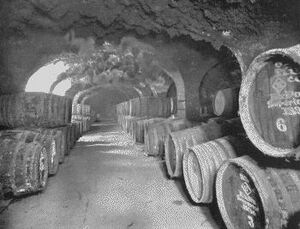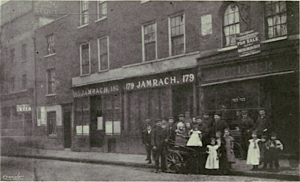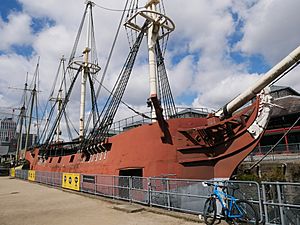Tobacco Dock facts for kids
Tobacco Dock is a really old and important building in Wapping, East London. It's a huge warehouse that was finished in 1812. It was designed by a Scottish engineer named John Rennie the Elder. This building was mainly used to store tobacco that came into London by ship, which is how it got its name!
For a long time, Tobacco Dock was a busy place. But after the two World Wars, ships stopped coming to this part of London. By 1969, the London Docks and nearby St Katharine Docks had closed down.
After the docks closed, Tobacco Dock became empty and rundown. In 1989, it was turned into a shopping center, but it had to close just two years later because of money problems. For many years, it stayed mostly empty. It was even used as a place for soldiers to stay during the 2012 Summer Olympics in London!
In 2012, a company called Tobacco Dock Ltd brought the building back to life. Now, it's a popular place for big events and conferences, holding up to 10,000 people. It also has offices and shared workspaces. The building itself is owned by a company from Kuwait.
Contents
History of Tobacco Dock
A group of merchants and bankers started the London Dock Company in 1796. They planned to build the London Docks and got special permission to be the only ones to manage ships carrying tobacco, wine, and other goods for 21 years.
Deep under the tobacco warehouses were huge vaults, like the underground rooms of an old church. These vaults had strong stone columns and brick arches. They were part of a 20-acre "underground city" where wines and spirits were stored. It was always a cool 15.5°C down there, perfect for aging drinks.
| These vaults could hold about 8 million gallons of wine! In 1849, they contained thousands of barrels of port, sherry, French wine, brandy, and rum. |
In the Victorian era, people could get a special pass to visit these vaults. Women weren't allowed after 1 PM. Wine merchants would even give visitors samples of the different wines and spirits. Today, only four of these original vaults are left.
Later, from the 1860s, the ground floor of the warehouse was used for storing wool, furs, and animal skins. That's why it was called the "Skin Floor." Cork and molasses were also stored there.
A church leader named Reverend Harry Jones wrote in 1875 that about 300 cats worked at the Dock! They were "employed" to catch rats.
| The Docks had lots of rats, so about 300 cats were used to keep them under control. There were also dogs. One time, I saw a famous dog with her puppies near the 'bowl' of our Queen's Pipe. Her owner told me how many rats she had killed. But he had a complaint: the Company didn't pay for the dogs' food, but they did pay for cat food! I thought dogs would need food, while cats could find their own. |
The main entrance to the London Docks from the street was on Ratcliffe Highway, which is now called The Highway. This road was very old, a Roman road, making it perfect for trade. In 1600, someone described it as a "filthy straight passage" with small houses where sailors lived.
One famous shop on Ratcliffe Highway was "Jamrach's Animal Emporium," owned by Charles Jamrach, who was from Germany. He traded wild animals and his shop was also like a museum.
Jamrach also had a place in Betts Street and a warehouse in Old Gravel Lane. He was a top seller and buyer of animals, selling them to rich people, zoos, and circuses. He bought animals from ships arriving in London and other ports.
In 1857, a wild Bengal tiger escaped from its cage while waiting to be moved. It grabbed a young boy who tried to pet it. Jamrach quickly got a crowbar and hit the tiger three times until it let go of the boy. The boy was not hurt, but Jamrach offered his father £50 as an apology. However, the father sued Jamrach and ended up costing him £300 in legal fees. Jamrach later sold the tiger for £300, and the new owner made a lot of money by showing it off as "the tiger that swallowed a child."
Today, at the north entrance of Tobacco Dock, there's a 7-foot-tall bronze statue of a boy standing in front of a tiger. It reminds everyone of this exciting story.
Building Design
The Dock's Layout
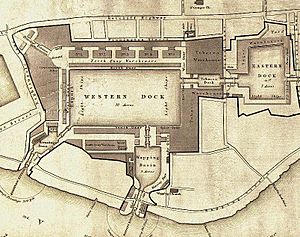
The name Tobacco Dock comes from its first job: storing tobacco and other valuable goods from the New World. It was part of the bigger London Docks project. Plans for the docks started in 1800, and building them cost £4 million.
Many houses and even a school were torn down to make space for the warehouses, offices, and docks. Tobacco Dock was one of these new warehouses. This meant many people lost their homes. Part of a churchyard was also used, so some graves had to be moved.
A magazine called Harper's New Monthly Magazine wrote that the London Docks covered more than 100 acres. They could hold over 500 ships and warehouses big enough for 234,000 tons of goods.
Building Style
The homes built for the dock workers were in a classic style called Georgian architecture, specifically from the Regency period. But the dock itself was designed to look like a prison to stop thieves.
Special Features
One thing you'll notice about Tobacco Dock from the outside are its tall walls. These walls cost £65,000 to build! They were needed because of strict rules for storing tobacco and liquor, which had special taxes called excise duty. These goods had to be kept in very secure places called bonded warehouses.
Another reason for the strong walls was to protect against thieves. In the 1800s, piracy was a big problem on the river. Groups like the River Pirates and the Mud Larks would steal from ships. The river was so crowded that 1,800 boats were often squeezed into a space meant for only 500!
Because of all this stealing, the company hired Daniel Asher Alexander to design the London Dock. He was also the main architect for famous prisons like Dartmoor Prison and Maidstone Prison.
The "Great Tobacco Warehouse" was also known as the Queen's Warehouse. In the middle of it was a large furnace called "The Queen's Tobacco Pipe." This furnace was used to burn tobacco that was bad or goods that people hadn't paid taxes on.
John Timbs' book Curiosities of London (1867) says:
| Near the Queen's Warehouse, a sign points to 'the Queen's Pipe', which is the chimney of the furnace. The furnace door has the royal crown and 'VR' painted on it. This furnace burns goods that don't sell for enough to cover their taxes. Tea is rarely burned because it once set the chimney on fire. Wine and spirits are poured into the Docks. The huge fire in the furnace burns day and night with unwanted goods. Once, 900 Austrian hams were burned; another time, 45,000 pairs of French gloves. Silks, satins, tobacco, and cigars are also burned in huge amounts. The ashes are sold as fertilizer, for killing insects, and to soap makers. Nails and iron pieces found in the ashes are valued for making gun barrels. Gold and silver from old plates, watches, and jewelry thrown into the furnace are also found in the ashes. |
What Happened Next
In 1990, the building was turned into a shopping center. This cost £47 million! The idea was to make it like a famous shopping area called Covent Garden in the East End. But it didn't work out, and the shopping center closed. This was probably because Tobacco Dock isn't in a main shopping area and isn't super easy to get to by public transport.
From the mid-1990s, the building was almost empty, except for a sandwich shop. A plan to turn it into a factory outlet store also failed. In 2003, English Heritage put Tobacco Dock on a special list called the Heritage at Risk Register. This was to stop it from being damaged or ignored, even though it was already a protected building.
In 2004, a meeting was held with the owners, a company from Kuwait, to make sure the historic building would survive. An English Heritage spokesperson said, "Tobacco Dock is very important. It's too big and important to be left empty. It's one of London's most important buildings, and if it's used again, it would make the whole area better." In 2005, the owners said they were planning to use Tobacco Dock for different things, like a hotel, shops, and fancy apartments.
Events and Filming
In 1980, the top floor of Tobacco Dock was used to film the music video "Messages" by the band Orchestral Manoeuvres in the Dark. In 2004, part of the building was used for the TV show Shattered. Many movie after-parties have also been held there.
Tobacco Dock was used for scenes in the BBC drama Ashes to Ashes in 2008. In 2011, a special "Secret Cinema" event for the movie The Red Shoes was held there.
In the summer of 2012, the Ministry of Defence used Tobacco Dock as a temporary home for 2,500 soldiers. These soldiers were helping to guard the 2012 Summer Olympics in London.
What's Happening Now
Tobacco Dock is now a popular place for big company events and parties. It's a smoke-free place, even in its car park.
- In 2013 and 2014, it hosted RuneFest, an event for the online game RuneScape.
- Since 2013, it has been the home of Meatopia, a yearly food event where chefs cook for over 10,000 people.
- Since 2014, the British Academy Games Awards have been held there every spring.
- Big dance events, organized by LWE, have been held regularly since 2014, with up to 5,000 people attending.
See also
- Stanley Dock Tobacco Warehouse, in Liverpool; the world's largest brick warehouse
- Stepney Historical Trust


